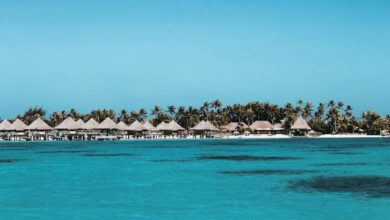Gorongosa National Park: Africa’s Untamed Gem
Discovering the Wonders of Gorongosa National Park: A Rebirth in Mozambique

Gorongosa National Park, located in the heart of central Mozambique, is a true gem that has undergone a remarkable transformation.
Once a thriving wildlife haven, the park suffered greatly during the country’s civil war, with its animal populations decimated by as much as 95%.
However, thanks to the tireless efforts of conservationists and the Mozambican government, Gorongosa has been given a new lease on life, and it’s more magnificent than ever before.
A Brief History of Gorongosa
Gorongosa National Park has a rich and fascinating history. Once home to some of the densest wildlife populations in Africa, the park suffered greatly during the Mozambican Civil War, with large mammal numbers reduced by as much as 95%.
However, thanks to the tireless efforts of conservationists and the local community, Gorongosa has undergone an incredible transformation in recent years.
Also Read: Discovering Amboseli National Park
In 2008, the Government of Mozambique and the Carr Foundation formed a 20-year public-private partnership to jointly manage the park and promote human development in the surrounding communities.
This partnership has been a resounding success, with Gorongosa now being hailed as one of Africa’s greatest conservation stories.
A Unique Ecosystem Shaped by Water
Gorongosa National Park is situated at the southern end of the Great African Rift Valley, encompassing a vast area of 3,770 km².
The park’s diverse landscape includes the valley floor, parts of surrounding plateaus, and a mosaic of different ecosystems.
From grasslands dotted with acacia trees and savannah to dry forests on sands and seasonally rain-filled pans, the park is a true feast for the senses.
The heart of Gorongosa is the Urema Lake, which is fed by numerous rivers flowing from the surrounding plateaus. During the rainy season, the lake expands, covering up to 200 km² of the valley floor.
This constant expansion and retraction of the floodplains, combined with the patchwork of savanna, woodland, and thickets, creates a complex mosaic of smaller ecosystems that support an incredible abundance and diversity of wildlife.
Exploring Gorongosa’s Diverse Ecosystems
One of Gorongosa National Park’s most striking features is its incredible diversity of ecosystems. From the valley floor’s seasonal flooding to the towering plateaus and stunning rain forests, there is always something new to discover.
The Valley Floor
The valley floor of Gorongosa is a mosaic of distinct ecosystems, including:
- Grasslands dotted with patches of acacia trees
- Savannah
- Dry forest on sands
- Seasonally rain-filled pans
- Termite hill thickets
This combination of unique features creates a truly breathtaking landscape, perfect for exploring on foot or by vehicle.
Also Read: Rift Valley Lakes From Naivasha to Nakuru
The Plateaus
The plateaus surrounding Gorongosa are equally impressive, with their own unique ecosystems:
Miombo and montane forests
A spectacular rainforest at the base of a series of limestone gorges
These areas are perfect for hiking and birdwatching, with over 500 bird species calling Gorongosa home.
Wildlife Encounters
Of course, no visit to Gorongosa would be complete without encountering the park’s incredible wildlife. Thanks to the conservation efforts of recent years, many of the park’s iconic species are making a strong comeback.
The Big Five
While Gorongosa may not have the full complement of the Big Five (no rhinos), it is still home to some of Africa’s most impressive animals:
Elephants: Gorongosa’s elephant population has recovered well after being depleted during the civil war, and visitors can often see large herds splashing around in the park’s waterholes.
Lions: Gorongosa’s lions have become increasingly habituated in recent years, and visitors are often treated to quality sightings of these majestic predators.
Leopards: Several leopards have been reintroduced to the park in recent years, helping to fully restore Gorongosa’s ecosystem.
Buffalo: While still scarce, buffalo can be spotted in the park.
Restoring the Park to Its Former Glory
In 2004, the Mozambican government and the Carr Foundation, a US-based non-profit organization, joined forces to rebuild Gorongosa’s infrastructure, restore its wildlife populations, and spur local economic development.
Over the next three years, the Carr Foundation invested more than $10 million in this effort, completing a 60 km² wildlife sanctuary and reintroducing buffalo and wildebeest to the ecosystem.
The restoration project team also began reconstructing Chitengo Safari Camp, the park’s main accommodation area.
By 2008, the government and the Carr Foundation had signed a 20-year agreement to continue the restoration and co-management of Gorongosa.
A Thriving Ecosystem Once Again
Today, Gorongosa National Park is a thriving ecosystem, home to an astounding diversity of animals and plants. Thanks to the removal of over 27,000 traps and snares by park rangers and the reintroduction of key species, wildlife populations have rebounded significantly.
Visitors to Gorongosa can expect to see a wide variety of animals, including elephants, lions, leopards, hippos, and a vast array of bird species. The park also boasts a unique limestone gorge that is home to a spectacular rain forest.
Ecotourism and Conservation
Gorongosa’s rebirth has also brought about a surge in ecotourism. The park offers a range of activities for visitors, including guided game and birding walks, night drives, and exclusive experiences as part of the restoration project.
These eco-friendly initiatives not only provide economic opportunities for local communities but also help to fund ongoing conservation efforts.
Conclusion
Gorongosa National Park is a true testament to the power of conservation and the resilience of nature.
From the depths of despair during the civil war to a thriving ecosystem once again, Gorongosa’s story is one of hope and inspiration.
As we continue to face the challenges of climate change and habitat loss, it’s more important than ever to support conservation efforts like those taking place in Gorongosa.
By visiting the park and supporting its initiatives, we can all help preserve this incredible natural wonder for future generations.
FAQs
What is the size of Gorongosa National Park?
Gorongosa National Park covers an area of 3,770 km² in central Mozambique.
What types of ecosystems can be found in the park?
Gorongosa National Park is home to a diverse range of ecosystems, including grasslands, savannahs, dry forests, seasonally rain-filled pans, and a spectacular rainforest in a limestone gorge.
How did the park’s wildlife populations fare during the civil war?
During Mozambique’s civil war, Gorongosa’s large mammal populations were reduced by as much as 95%.
When did the restoration efforts begin, and who was involved?
In 2004, the Mozambican government and the Carr Foundation, a US-based non-profit organization, began working together to restore Gorongosa National Park.
What activities are available for visitors to the park?
Visitors can enjoy guided game and birding walks, night drives, and exclusive experiences as part of the restoration project.
What is the significance of Urema Lake in the park?
Urema Lake is the heart of Gorongosa, fed by numerous rivers flowing from the surrounding plateaus. Its constant expansion and retraction during the rainy and dry seasons creates a complex mosaic of ecosystems that support an incredible abundance and diversity of wildlife.
How has ecotourism impacted the park’s conservation efforts?
Ecotourism in Gorongosa National Park provides economic opportunities for local communities and helps to fund ongoing conservation efforts, ensuring the park’s continued protection and restoration.
Nestled in the heart of Mozambique, Gorongosa National Park is a true gem of Africa’s wilderness. This vast, untamed landscape, spanning over 4,000 square kilometres, is a testament to nature’s resilience and the power of conservation efforts.
From its lush grasslands and savannah to its towering plateaus and stunning rain forests, Gorongosa is a haven for a diverse array of wildlife and a must-visit destination for any nature enthusiast.





